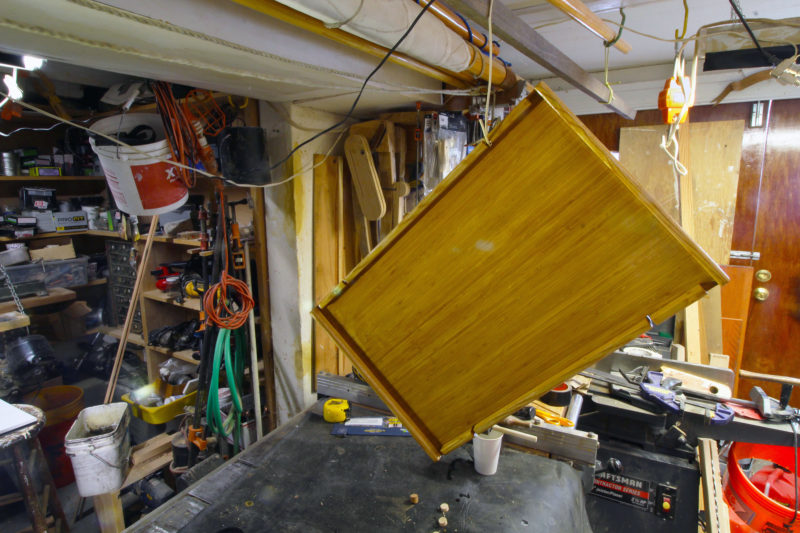
With a fresh coat of varnish, the chart holder hangs from the overhead. To get it to this point, I had to gather things from everywhere in the shop. I used a measuring tape, a combination square, the table saw, a table-saw sled, a stop block, a clamp, the dust collector, the bandsaw, the drill press and its hold-down, a plug cutter, the belt sander, a random-orbit sander, the compressor and nail gun, a cordless drill, a 1/4″ bit, Titebond III, a flock of drafting ducks, superglue and accelerator, a disposable bristle brush, nitrile gloves, my painting apron, a foam brush, lacquer thinner, a piece of a T-shirt for a rag, scissors, a paper cup, sandpaper, a foam pad over the table saw, a sanding block, a scraper, a chisel, a hot knife, the shop vac, a length of wire, and wire cutters.
When I read David Cockey’s article about chart holders, I knew I needed to make one for myself because I use paper charts exclusively—they can indeed be awkward to handle—and I also enjoy woodworking projects. Unfortunately, spending time in my shop can be a mixed blessing. The tools and supplies I’ve accumulated since I began building boats in 1978 have overwhelmed the one-car-garage workshop they now occupy.
While there is a place for everything in my shop, there just isn’t enough space. The stocks of wood and metal I have leaning up against the walls and the tools piled on shelves are as unstable as mountain talus slopes. “Debris piles up to a characteristic angle of repose,” notes Encyclopedia Britannica, and “when new debris is added to the slope, thereby locally increasing the angle, the slope adjusts by movement of the debris to reestablish the angle.” It’s not uncommon while I’m working at the bench to hear something fall on the opposite side of the shop: an angle grinder, for example, sitting on a shelf 10′ away from me, spontaneously rolled off, dropped onto a box of soldering equipment sticking out from the shelf below it, and took it to the floor with itself, breaking one of the firebricks that was in the box.
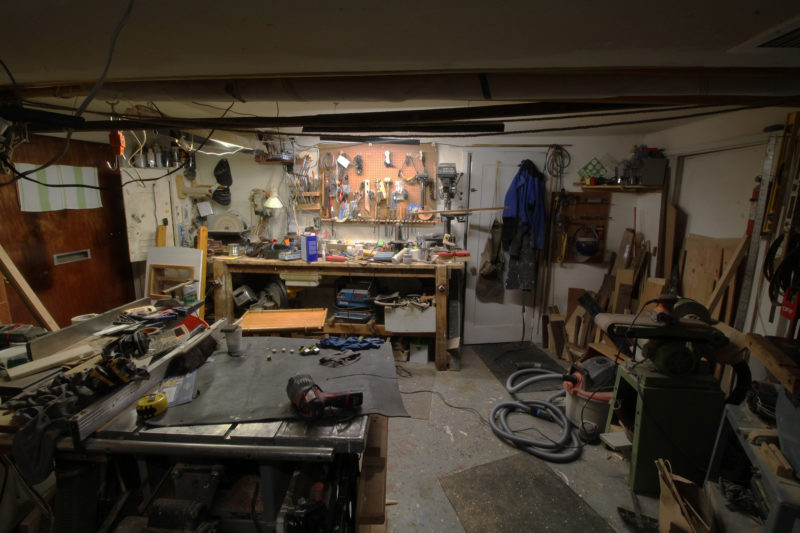
When my house was built in 1926 the car parked in this garage probably had wheels with wooden spokes. When I built my Caledonia yawl here, there was only room for the boat. All of the tools occupied the adjoining basement. Other boats occupied either the basement or the back yard.
More often, when I drop things I can’t find them (especially if they’re smaller than a half-dollar). The floor is speckled with drips and trails of paint, amber-like globules of epoxy, and wayward screws, nails, and staples. The Jackson Pollock–like pattern is as good at hiding dropped hardware and drill bits as Mossy Oak camo clothing is at concealing hunters. The back third of my workbench is devoted to storage for knives, tape, pencils, drill bits—and the rest of it (along with the table saw and jointer) can get so cluttered during a project that when I put a hammer down and turn my back it’s as good as gone.

The garage was built with an extension on one side. It’s now occupied by a mix of woodworking and metalworking equipment.
Working in my shop is a bit like delving into the I Spy books I enjoyed with my kids when they were very young. On each page of the books is a photograph of dozens of miscellaneous scattered objects with a rhyme that names items to find: “I spy a lion and eight other cats, a shell from the ocean, a fish who wears hats.” In my shop it’s: “I’ve misplaced my chuck key, a stainless-steel screw, two ball-peen hammers, and the cap for the glue.” There’s a satisfaction in finding things, but nothing in an I Spy book is burdened with the annoyance of having lost the hidden objects in the first place.
I’ve worked in tidy woodworking shops, so I know such places exist. I’ve had woodworking jobs in two Smithsonian Institution museums making displays and at Seattle’s Dusty Strings building hammered dulcimers. The floors in those shops were always swept clean, and every tool and every unused clamp was put back where it belonged after use so others would be able to lay hands on them. I don’t know why it has to be so different in my own shop. I like to think that more space would make a difference, but the shop once occupied most of my home’s basement and it was every bit as cluttered.
Now that my kids are on their own, I plan to move to a smaller home that has a big, detached garage where I can spread out. I can imagine having all my tools and supplies as neatly arranged as they would be in a Smithsonian workshop. I might set it up that way, but I worry that Shakespeare is right that “what’s past is prologue.” A character flaw would seem to be at the root of my disarray, but I finished the chart holder losing only a cabinet scraper (and not my temper) and I think it came out okay.
For fans of the I Spy books, here are lists (with my apologies, not set to rhyme) of items in the photographs here (click on the photos for a larger, sharper view). All of the objects included appeared in articles in Small Boats Magazine and are linked to them.
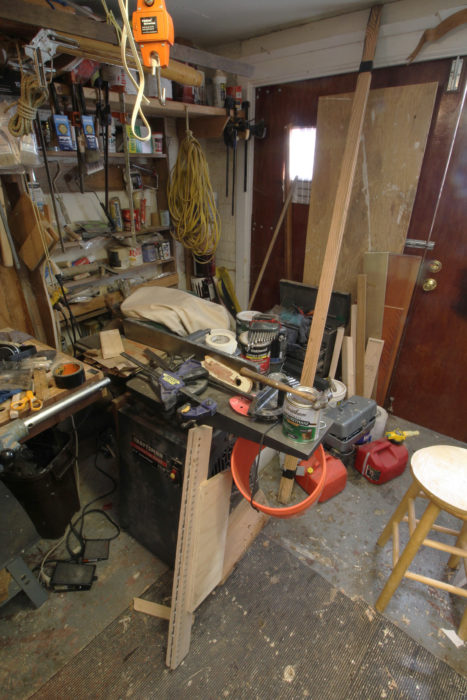
I spy a gas can with a spout, a roll of gaffer’s tape, two pedal switches, a modified bucket for a Duckworks Small Boats Head System, a downdraft table, a bungee with a Zeppelin knot, BONZO’s mast, a washer table-saw roller, and two Red Devil scrapers.
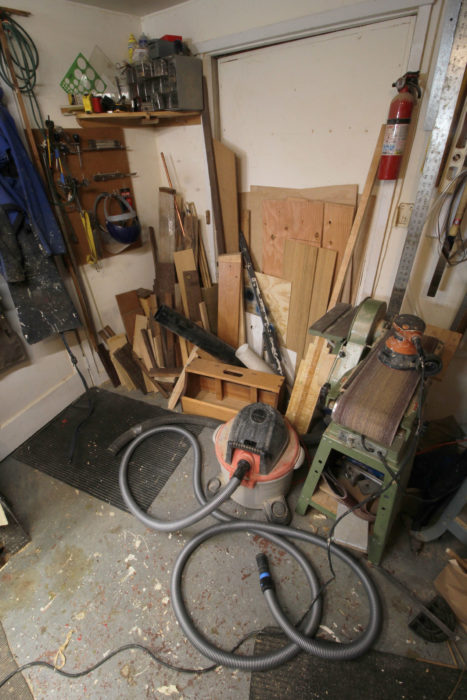
I spy a dust-collection hose, a digital measuring tape, 4″ PVC pipe for making Aleut visors, Joe Liener’s tool tote, and a paddle blank glued with rubber-strip clamping.
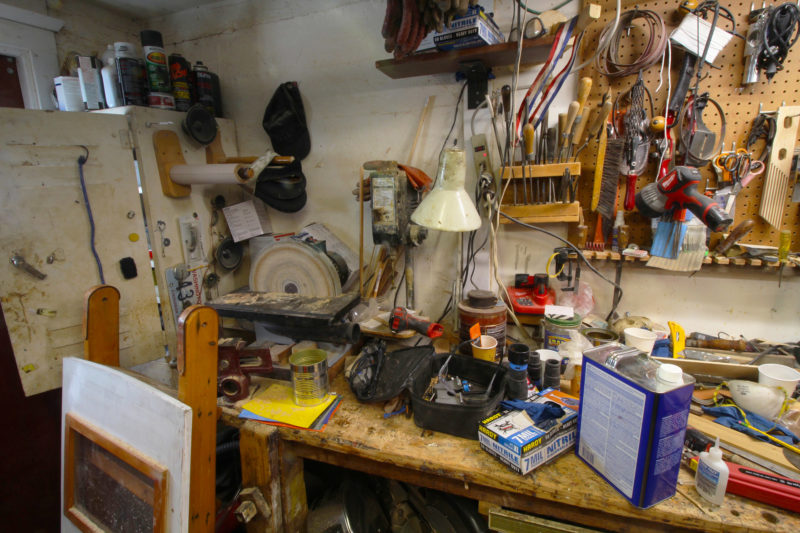
I spy a Versa Vice and its adapter, an impact driver with battery and charger, belts for an electric file, acid-sharpened files, a Shinto rasp, three vacuum-hose fittings, BONZO’s cabin door, and a cabinet scraper.
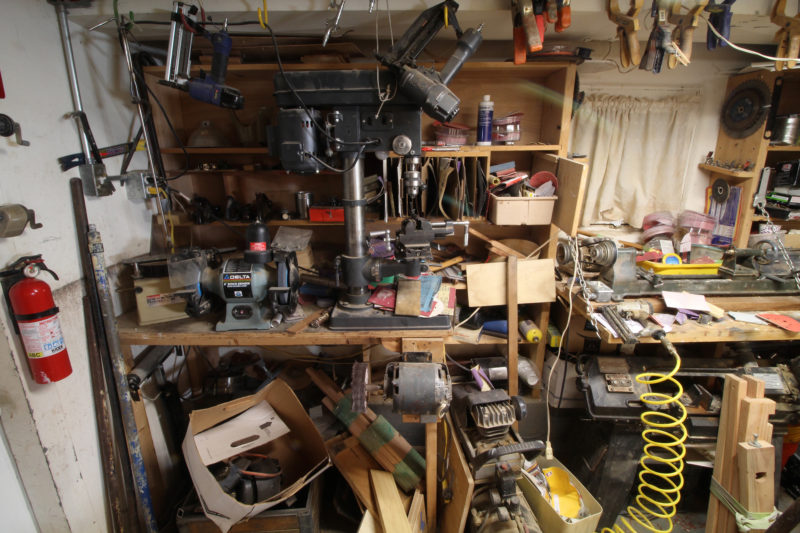
I spy Phil Thiel’s drill press, a Bernzomatic torch, a Makita sharpener, a Gränsfors hatchet, a stropping paddle, and a homemade grapnel.
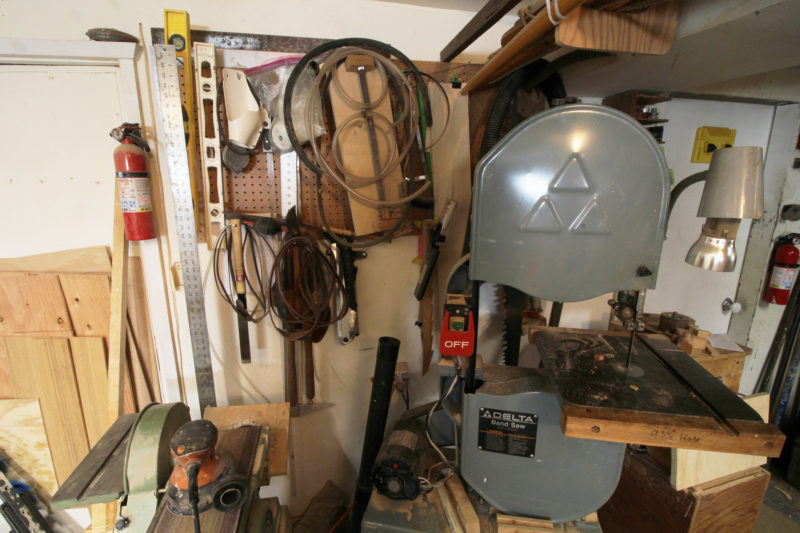
I spy a joggle stick, a Silky saw, a bandsaw log sled, HESPERIA’s sprit, a Magswitch featherboard, two Nata hatchets, and a safety switch.
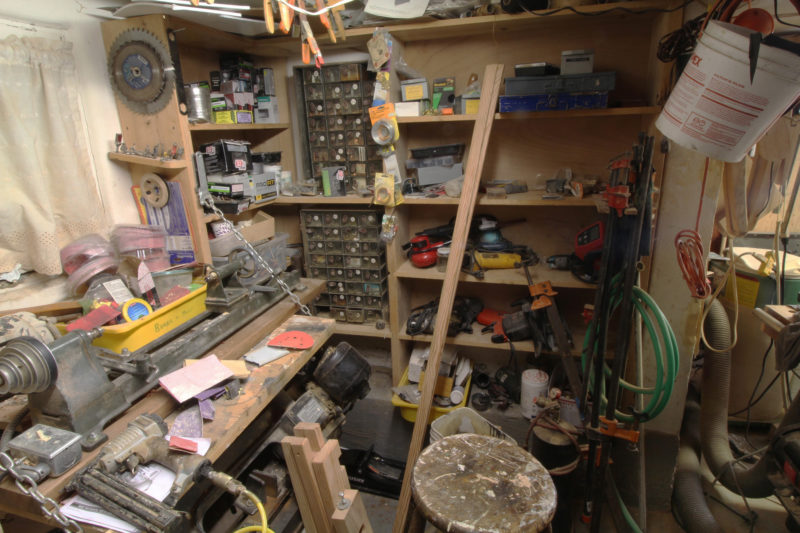
I spy a bucket of rubber strips, a Milwaukee air pump, an angle grinder, a carbide angle-grinder disc, a Dremel multi-tool, a cam-lever clamp, a Krenov sawhorse taken apart, Phil Thiel’s lathe, silver-solder flux, and an electric file.
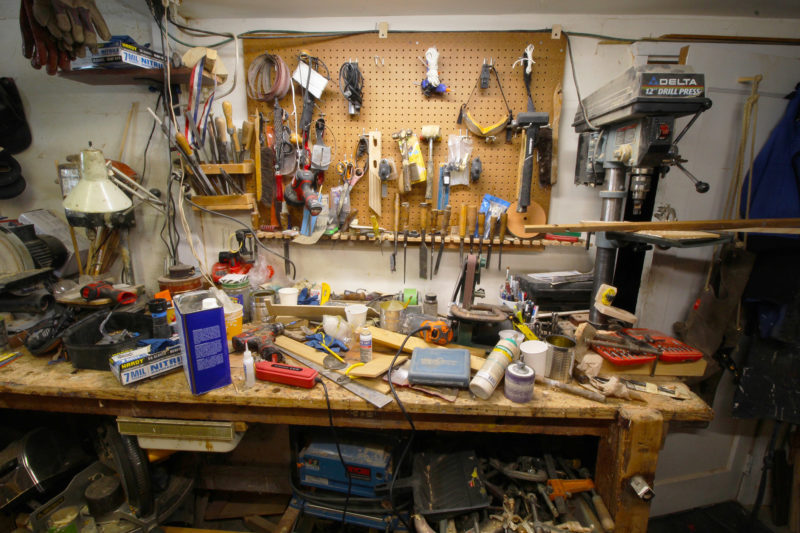
I spy a hot knife, a Rigid router, DeWalt goggles, rust erasers, a sleeveless sanding drum, a leather stropping wheel, light cast by an LED-strip fixture, a Harbor Freight 1×30 belt sander, and a Best Coast Canvas Verksted apron.

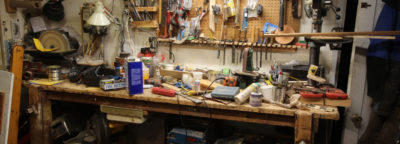
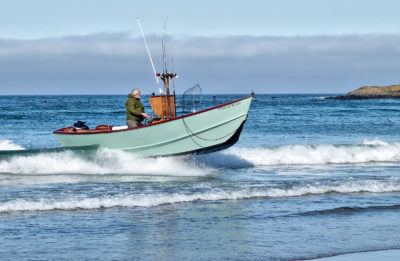

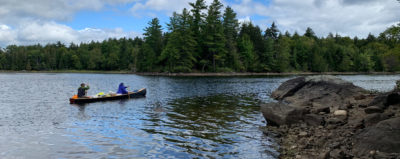

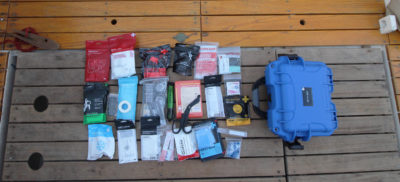
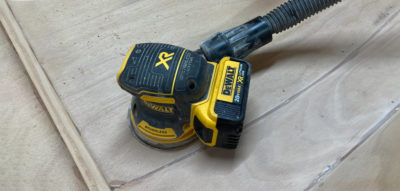
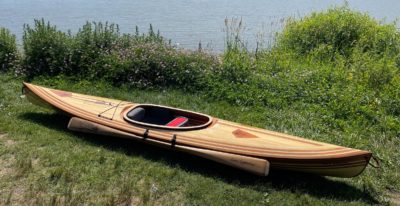
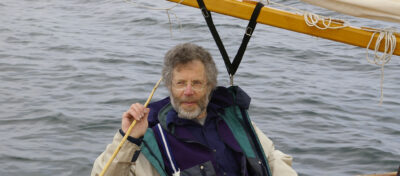
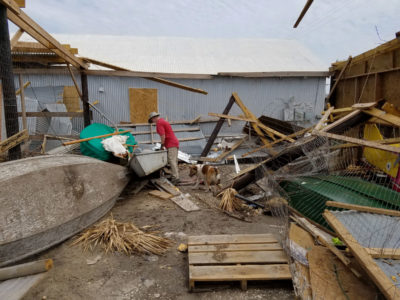

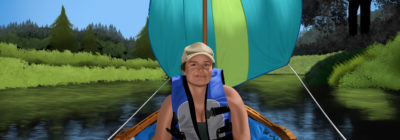
Ah, to view a like-minded craftsman in a similar shop, organized in a similar manner as mine, makes me reappraise my untidy habits, not as bad, but acceptable, it’s the way I am, and the way I work, but it can drive me nuts when I can’t find the tool I just put down!
Thank you. I thought I was the only one.
That was fun; my shop is about half that size and also holds paddling and sailing gear. There are no places for fixed power tools. And I never put things away when I break them out. I do save big pieces of flat cardboard for the floor, helps standing and, in winter when the shop barely breaks 40, it’s a little easier on the feet.
When viewed in my Browser, I was able to identify many items that were in the photos but not on your lists. I also identified whole sections of text and accompanying photos that were not visible when viewed in the SBJ App (iPad 11″pro, latest version of iPadOS). I did, however, like this article and the other articles in this issue when they appeared whole on my Browser.
(Sorry. It is April Fools Day and I couldn’t resist the tortured prose to describe what looks like a bug in the SBJ App.)
Looks good to us. Clean shop = cluttered mind.
The most wry boatbuilding article I have read.
What a lovely article! If it is a character flaw at the root of such arrangements, you are in good company (and likely a large group!)
In the Shop Corner – a Poem for Chris
When into my cluttered shop I venture out,
What do I find but a gas can with a spout?
Intending to work wood to a pleasing shape,
Will there be use for a roll of gaffer’s tape?
Where are my two pedal switches, and Zeppelin knotted bungee – maybe I’ve missed ‘em?
There they are, stowed inside a modified bucket for Duckworks Small Boats Head System.
Behind the washer table-saw roller and downdraft table,
I hope that below HESPERIA’s mainmast, at last I’ll be able,
With my two handy Red Devil scrapers,
To carry on with my woodworking capers.
My garage looks quiet similar, tools and parts for boats and bikes. I swear, when I’m retired, I will … 🙂
Be forewarned……after 3 years of retirement, my garage shop still awaits its moment of transformation, LOL. It’s too easy to pick up a tool and continue where I left off or take the bike out for a spin. My shop and I completely identify with this article!
You sir are not well….ha ha ha…
One comment- toward the front of the article you say that when you worked in other shops – “every tool and every unused clamp was put back where it belonged after use so others would be able to lay hands on them.” You have to adjust this thought to say “…so I can lay hands on them again.” I too have a shop with a lot of tools, and I do make my living with them, but if I didn’t put things back in their place on a regular basis, I could not find anything in short order.
This is a wonderful article where there is great insight into small space and clutter. I find myself perfectly in this situation. My workshop is 4m x 4m,16 square meters.
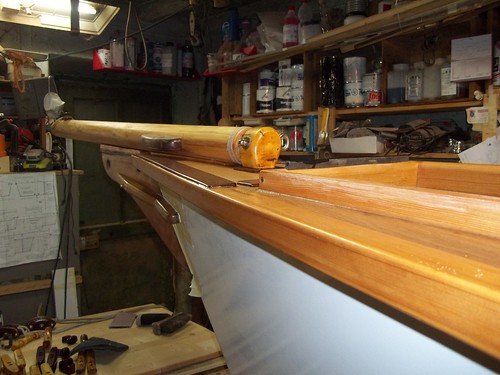
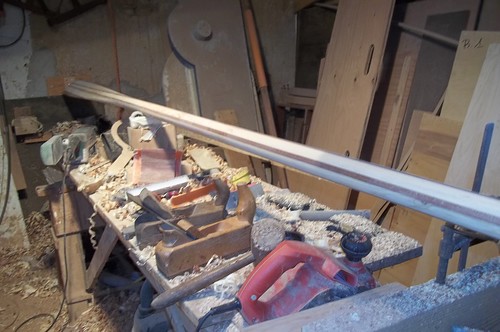
Fascinating article. What a shame we can’t post images on here to show each other our own working environments, tidy or otherwise!
You can include photos with a comment by sending the image files to me. At the top of the Comments column, under “Join the Conversation,” there is a note about including photos and a link to my email address. I look forward to seeing some reader workshops.
Christopher Cunningham, Editor
[email protected]
Here’s an image of my workshop – a ‘work in progress’ within my garage
I’m very conscious of how tidy it looks but it has one or two points of interest: firstly, ‘Marazan’ my 12ft Essex Smacks boat, balanced lug rig. The bench beyond is made from 3 sheets of birch faced ply, to Paul Sellers’ design. Since this photo was taken I have added a refurbished Record 52 ½ vice, salvaged from my old secondary school – I may even have used it when I was a teenage student there in the early 80’s.
The final thing to point out is the squadron of 1:72 Airfix plastic model kits (in ‘line abreast’ formation) expertly made by MARAZAN’s able crew – my two young sons
I thoroughly enjoy Small Boats Monthly – keep up the good work!
Best regards,
Paul Pearson
Wow, I guess most of us boat builders found a common denominator with those pictures. My saving grace is the fact I share our garage with my wife’s car. Every evening I move all my portable tools to one side and vacuum the floor. Her car then goes back into the garage. When the workbench begins to disappear beneath a plethora of hand tools I am forced to start putting things away.
You win, Chris. My shop can be messy but….. Oh my word!
A real working shop of many trades look similar. If it’s too clean and organized it usually means you aren’t getting much work to have that much cleaning time. Order through chaos.
This is how my shop looks, and then some very often, and I do most of the work out in the carport or barn pad, or inside the winery, toting tools out and back with me as I go. It’s so easy to move on to the next task, or the next demand, or the next day. Then suddenly it’s time for spring cleaning before the beautiful weather arrives.
My workshop is very similar. There are places for things but they are seldom in them. I recently went to change the blades in my hand-held power plane and lost a small part of the blade set up. I cleaned off the bench, put everything away that had a home, and put all of the stray nuts and bolts, one at a time, into tins. I still did not find the part, so I took the tool to the power-tool repair man and got him to fit new blades and get the lost part.
I can only say that if you get a bigger garage/workshop, you will in a few years just accumulate more “stuff” to fill the available space. My garage used to hold two cars and working space, but now the cars are out in a carport and the space inside is full of things mechanical and woodworking. My current project: a canoe.
I am sure i have solved the problem of matter transfer. All I need to do is find where the article goes!
Cheers
Denis in Adelaide south Australia
I found it interesting reading the comments of others with shops. The old adage that a messy shop is a busy shop is only said by persons with the messy shop. I have known tradesman that would purposely mess up their shops so that it would appear that they were busy. As a tradesman and a teacher of the trades, I always instilled that a neat shop is a safe and productive shop.
I am a Master Craftsman who takes pride in my work and my shop.
Type A personality, you bet.
Great Small Boat Magazine.
Thanks
@metoo moment looking at your pics.. wish i had the level floor!
Wonderful tour. Would that I had the skills to match my tools as your skills transcend the tools. My wife tells me that the 4 kayaks hanging from the ceiling look good — better than the Wherry row-to-sail conversion yet on the deck. I claim only a single point of pride — petrol is outside the barn. Thanks for the years of inspiring text and photos including the much missed Sea Kayaker articles.
“I Spy” prompted 3 thoughts.
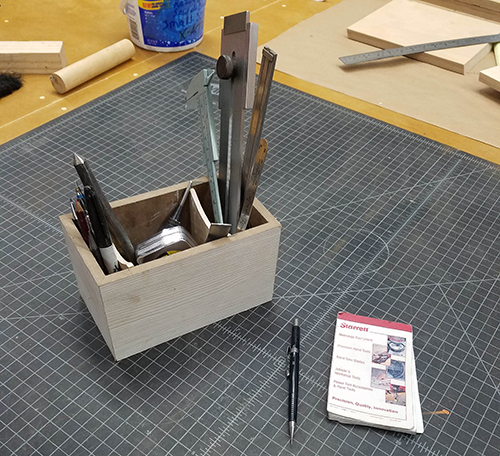
1) Would a shop with a funnel-shaped floor work better?
2) It is annoying to lose a tool or a part, but several months later there’s unanticipated joy at finding it again.
3) The picture attached show two things that help compensate for my age–a pad and pencil, kept in my shirt pocket–if I think of something, I stop whatever I’m doing and right it down. No more thinking to myself, “I’ve got to remember to get a doodad for the thingamajig.” The small box stays with me on my workbench and has a tape measure, 6″ rule, dial caliper, plastic vernier caliper, marking gauge, small square, scribe, center punch, chalk, soapstone, marker and pencils; what’s in there goes back once it’s used. I only had to wait until I was 72 to come up with it. Otherwise everything in the shop is uncharted territory.